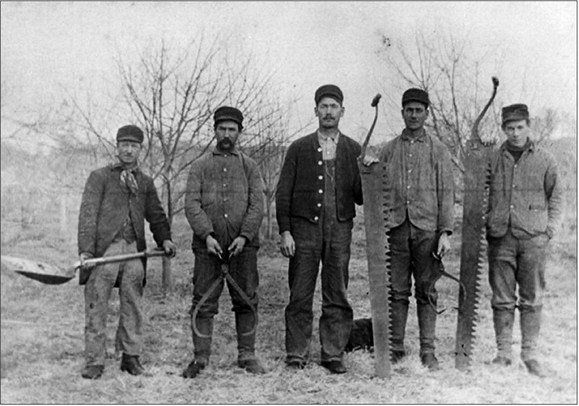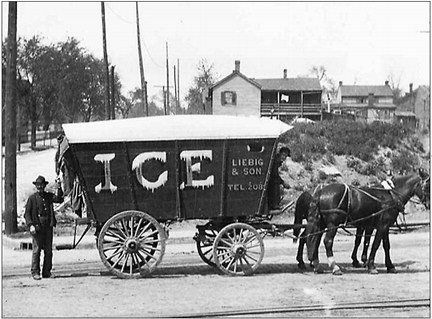Cutting ice on Quincy Bay

In the 1870s the business of cutting "natural ice" on Quincy Bay was considered among the most important branches of industry in Quincy. The large amount of money paid in mid-winter furnished employment for as many as 1,500 men at a time when they would otherwise be unemployed.
The harvest scene at the bay was a lively one, for there were many companies, each working a group of men and horses in its own section of the bay at the same time.
The larger wholesale companies filled their icehouses, and loaded barges to ship down the river as soon as the beginning of spring would permit. Some retailers required customers to collect their own ice from the storage house, while others delivered to houses and businesses. Heavy draft horses pulling ice wagons from door to door became a familiar sight. Icemen delivered block ice which was placed in iceboxes, insulated wooden chests in which food items could be stored. Neighborhood children looked forward to the coming of the iceman, who would chip off pieces of ice as a treat for them during the summer. A recent "Once Upon A Time In Quincy" article mentions soda and ice cream being served at the Heidbreder and Drallmeier Drug Store in 1902, kept cold with ice harvested from Quincy Bay.
A number of companies and individuals were engaged in the ice-cutting business, among them being James Jarrett, J.A. McDade Co., Hutmacher and Kreitz, Liebig and Son, and the Pure Ice Company. There were some conflicts. In February 1901 the Pure Ice Co. filed a complaint for injunction against the Hutmacher Ice Co. An agreement was reached, however, allowing Hutmacher a channel along the sandbar for its field and the Pure Ice Co. a channel in the field of the Hutmacher Co.
Around the turn of the century there were at least 17 icehouses along the bay front. Built largely of stone, because of its insulating properties, they kept large stocks of ice with surprisingly little melting through the summer months. If the river flooded in the spring, some houses would be inundated with water, the ice would float, and the building might dramatically collapse because of the floating ice pushing out the walls. Dick Brothers Brewery had an icehouse on the bay, plus four icehouses on Spring Street as well as those at the brewery. Ruff Brothers Brewery also put up a new icehouse near their brewery on South 12th Street. The stone icehouses on the bay were demolished in 1930, and the stone was hauled to the west approach of the Quincy Memorial Bridge (opened June 30, 1930), to be used as rip rap.
To harvest the ice, first a sharp-pointed plow, drawn by heavy draft horses, marked off long lines about two feet apart. Then cross sections were drawn. After this scoring was done, men inserted long, piked poles along the lines, and with a sharp push, caused the ice to clear into straight-sided blocks.
When this failed, saws made the final cuts. Workers then pushed the blocks through channels opened to the shore and barges. Ice ranging in thickness from 10 inches to a foot was considered ideal because it could be easily grabbed by tongs. In the early days, men with ice tongs heaved the 200 pound blocks into their storage places; later, horses were employed to operate racks moving the ice; and eventually, chain conveyors, creaking and rattling, carried the frozen chunks into the icehouses or barges. The big blocks were packed in straw, granulated cork, and sawdust to prevent melting.
Ice-cutting was dangerous work. A Herald-Whig article reported that in January 1901 four men fell through the ice on the bay. Then in February a Hutmacher team of horses fell through the ice and was rescued only with difficulty. A few weeks later a large field of ice suddenly became detached from the shore and floated off downstream. Harvesters left their horse and tools on the ice, making a run for the shore to save their lives. One man, Enos Reiney, ran back onto the ice field at the risk of his own life to save the horse and tools.
Rudolph Hutmacher was born Feb. 28, 1836, in Dorsten, Westphalia. He went into the ice business in 1854, and was the first man in this region to cut ice from the bay and store it in icehouses to be sold during the summer months. His partner, John Matthew Kreitz, came to Quincy from Germany in 1850, after a stay in Guatemala.
Rudolph Hutmacher was the first harvester of ice to ship on barges to the south. In 1878 he received great acclaim for sending barge loads of ice to New Orleans, ice that was greatly needed because of the yellow fever epidemic there. In 1904 the Hutmacher company secured a contract with the CB&Q railroad company and supplied that line and several others with natural ice for shipment and for use in refrigerator cars. Rudolph Hutmacher is the great-grandfather of Quincy attorney Matt Hutmacher.

In peak years 200,000 tons of ice were taken from the river and the bay -- mostly from the bay, which yielded the best ice. Fed by springs and creeks flowing through limestone cliffs, the water was clean; and it made crystal clear ice, reputedly the best in the Mississippi Valley. Ice was also harvested further up the river, including Keokuk and Burlington, Iowa, which generally had the advantage of colder weather. Sometimes ice fields would be plowed at night to allow the cold to get below the ice and freeze it to thicker depth.
A high river stage spoiled the ice harvest in 1928 and the winters from 1929 to 1932 were too warm. From that time on no ice was cut on the bay. With metropolitan growth, many sources of natural ice became contaminated from industrial pollution or sewer runoff. In 1921, when winter weather became fickle, Hutmacher and Kreitz established an "artificial ice" plant, a plant which manufactured ice, to carry out their contracts. Manufactured ice and electric refrigeration eventually ended the annual harvest.
As electric and gas refrigeration progressed, the demand for artificial manufactured ice also declined rapidly. However, iceboxes, using artificial ice, were still being used in 1946. And even after the development of artificial ice, the Hutmachers still used a "season storage facility," an icehouse, which was necessary to furnish ice in excess of what the machinery was able to turn out during the peak season.
Robert Cook recently retired as a justice of the Illinois Appellate Court. He is a member of the board of directors of the Historical Society.
Sources
David F. Wilcox, Quincy and Adams County, History and Representative Men, volume 1, 1919, pp. 397-98, pp.424-25 .
Joan Hunter, Ice Harvest Days, The Living Museum, Illinois State Museum, 1969?
Obituary of Al Hutmacher, Quincy Herald-Whig, May 1942.
Description of Historical Society exhibit, "Quincy's Riverfront, From Ice Cutting to Clat Adams' Store," April 3, 1993.
Carl Landrum, Cutting Ice was early industry, Quincy Herald-Whig, February 27, 1966.
Cold Recalls Ice-Cutting Days; 200,000 Tons Harvested in Peak Years, Quincy Herald-Whig.
Pure Ice Company Observes Fiftieth Year in Business; Company Founded by Jesse E. Weems Has Had Steady Growth, Quincy Herald-Whig, September 15, 1946.
Hutmacher Ice Company, Old Business of Quincy, Sold to Galesburg Firm, Quincy Herald-Whig, July 7, 1928.
Flames Complete Work of Wrecking Ice House on Bay; Razed Hutmacher Storage Place Burns Sunday Afternoon and Night, Quincy Herald-Whig, January 6, 1930.
Francis J. Bunce, ‘Quincy Bay'--memories of youth, Quincy Herald-Whig
Carl Landrum, From Quincy's Past; ‘Natural Ice' harvest of 1900-01, Quincy Herald-Whig, February 22, 1975.
Carl Landrum, From Quincy's Past, New Bridge spans Mississippi, Quincy Herald-Whig, February 28, 1982.
Carl Landrum, Icy, snowy winter of 1873 was one to talk about, too, Quincy Herald-Whig, March 19[?], 2000.
"Icebox," Wikipedia, last modified 13 February 2014.






